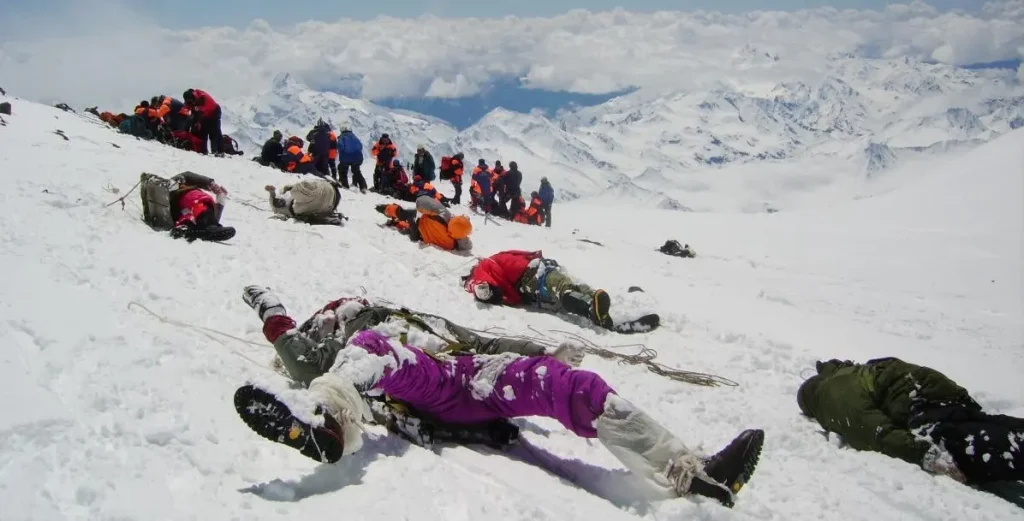Mount Everest stands as the pinnacle of human ambition, a siren call drawing adventurers from across the globe to test their limits against the world’s highest peak. Yet, this dream often collides with unforgiving reality, where triumph can swiftly turn to tragedy. Amid the frozen expanses lies Rainbow Valley Everest, a name that evokes whimsy but conceals a grim truth. It is a stretch of terrain scattered with the remains of climbers, their brightly colored gear splashed across the snow like a macabre palette. Located above 8,000 meters on the Northeast Ridge, within the infamous Everest death zone, this area serves as a stark reminder of Everest’s perils.
Rainbow Valley Everest exists due to the lethal combination of extreme altitude, treacherous conditions, and the impossibility of rescue or recovery in such environments. It symbolizes not just the physical toll of high-altitude mountaineering but also the human stories of loss, resilience, and ethical dilemmas. Beyond the personal tragedies, it highlights environmental degradation from decades of expeditions, prompting debates on sustainability and respect for the mountain. As Everest’s allure persists, Rainbow Valley Everest underscores the profound impacts on individuals, local Sherpa communities, and the fragile Himalayan ecosystem.
What is Rainbow Valley Everest
Rainbow Valley Everest is a haunting nickname for a specific section of the upper slopes, where dozens of preserved bodies and discarded expedition equipment create an eerie, colorful mosaic against the perpetual white of snow and ice. Far from a vibrant paradise, it is an open-air Everest graveyard, primarily along the Northeast Ridge route from the Tibetan side, just below the summit pyramid. Climbers encounter it during the final push, navigating past frozen figures clad in vivid down suits—reds, blues, and yellows—that give the area its ironic name. These colors stem from modern mountaineering gear designed for visibility and warmth, now eternally contrasting with the barren Himalayan landscape.
Geographically, Rainbow Valley Everest occupies a shallow depression at around 8,500 meters, marked by steep ridges, deep crevasses, and unstable seracs. The terrain is merciless. High winds scour the surface, avalanches reshape paths, and the thin air amplifies every misstep. In Everest climbing lore, it has become a legendary waypoint, whispered about in base camps as a symbol of the mountain’s indifference. First coined by Sherpas and climbers in the late 20th century, the term gained notoriety through accounts such as Jon Krakauer’s Into Thin Air, which described the 1996 disaster. Today, Rainbow Valley represents the cumulative toll of over a century of ascents, where ambition often meets mortality.

The Everest Death Zone Explained
The Everest death zone refers to altitudes above 8,000 meters, where the human body rapidly deteriorates due to extreme oxygen deprivation. At this height, atmospheric pressure drops dramatically, providing only about one-third of the oxygen available at sea level. Without supplemental oxygen, climbers face a ticking clock: the body cannot repair damaged cells, heal injuries, or function normally. Even with oxygen tanks, acclimatization is limited, and the body undergoes immense physiological stress.
Consequences are dire. Exhaustion sets in quickly, as simple movements require extreme effort. Frostbite claims fingers and toes in the biting winds and subzero temperatures. Altitude sickness manifests as high-altitude pulmonary edema, which fills the lungs with fluid, or high-altitude cerebral edema, which causes the brain to swell. Both are fatal without rapid descent. Judgment becomes impaired, hallucinations are common, and minor mistakes escalate into life-threatening crises. Rescues in the death zone are nearly impossible. Helicopters cannot operate reliably above 6,000 meters, and evacuating someone requires several Sherpas, oxygen bottles, and immense time, which are scarce during summit attempts.
Statistically, Mount Everest’s overall death rate is about 2.6 percent, with around 340 to 350 fatalities from more than 12,000 summits as of 2025. Since 2010, modern gear and weather forecasting have reduced the rate to under 1 percent, but the sheer volume of climbers creates higher raw numbers. Compared to other 8,000-meter peaks, Everest is considered less lethal than Annapurna, which has a fatality rate above 30 percent, or K2, which hovers near 25 percent. Yet its popularity and overcrowding in the death zone make Rainbow Valley particularly dangerous, turning survival into the true achievement.
Why Are Bodies Left on Rainbow Valley Everest
Leaving bodies behind on Everest is a heartbreaking reality driven by impossible logistics, financial barriers, and the immense danger of retrieval. At altitudes like Rainbow Valley Everest, a body effectively weighs double due to gravity, bulk, and frozen rigidity. Moving one requires six to ten Sherpas, each risking their lives while using valuable oxygen. Narrow ridges, deep crevasses, and unstable ice make such missions perilous, often leading to further accidents.
The financial cost of recovery is staggering, ranging from $40,000 to $80,000 or more. Families may not have these resources, and most insurance policies exclude recovery operations in the death zone. Sherpas often refuse to endanger themselves for such tasks, prioritizing the living instead. Many also believe in the mountain’s sacred nature, where the dead should rest undisturbed as part of Chomolungma’s spirit.
Weather compounds the difficulty. Temperatures often drop below minus 40 degrees Celsius, storms strike without warning, and high winds freeze bodies solid within hours. Many become embedded in ice or wedged into terrain, impossible to extract without tools and time that would endanger rescuers. This is why frozen bodies on Rainbow Valley Everest often remain for decades, preserved by the harsh environment. Rainbow Valley has therefore become not only a geographic marker but also a chilling reminder of the mountain’s finality.
Famous Bodies and Stories in Rainbow Valley
Rainbow Valley Everest notoriety is closely tied to the well-known tragedies of climbers whose remains became landmarks. Perhaps the most famous is Green Boots Everest, an unidentified climber believed to be Tsewang Paljor, an Indian mountaineer who died during the deadly 1996 storm. His body, marked by fluorescent green boots, rested in a shallow cave at about 8,500 meters and served as a grim landmark for decades. Climbers often referenced his body to navigate the ridge. Though believed to have been moved or buried by snow around 2014, his legacy remains one of the most recognized in Everest history.
Another haunting figure is Sleeping Beauty Everest, the nickname for Francys Arsentiev, an American climber who in 1998 became the first U.S. woman to summit without supplemental oxygen. On the descent, she collapsed in Rainbow Valley, overwhelmed by hypoxia and exhaustion. Her husband, Sergei Arsentiev, attempted multiple times to save her but tragically fell to his death. Francys was discovered by a passing team still alive but immobile, and climbers could only comfort her before she passed away. Her body remained visible until a 2007 recovery mission finally brought her down the mountain.
Rainbow Valley also holds stories of climbers lost in other eras, including George Mallory and Andrew Irvine, who disappeared in 1924. While Mallory’s body was discovered decades later, Irvine’s remains are still missing, fueling debates about whether they were the first to reach the summit. The 2019 season also saw deaths from overcrowding, with traffic jams in the death zone leaving exhausted climbers stranded. These figures, from Green Boots to Sleeping Beauty, illustrate how personal tragedies become enduring symbols of Everest’s brutal reality.
How Many Bodies Are on Mount Everest
Since the first expeditions in the 1920s, Mount Everest has claimed between 340 and 350 lives. Of these, about 200 bodies remain on the mountain, preserved by the dry cold that prevents decay. Some are partially buried by avalanches, others revealed as glaciers shift, creating a grim cycle of disappearance and reappearance.
Rainbow Valley Everest contains one of the highest concentrations of these remains, making it a location both feared and remembered by climbers. Other areas like the Khumbu Icefall and the South Col also hold many bodies. The sheer number reflects Everest’s long history, but the continuing rise in annual fatalities highlights the risks that remain despite better technology and preparation. The mountain has become not only the ultimate test of endurance but also a repository of frozen history.

Sherpa Perspectives and Cultural Ethics
For the Sherpa people, Everest, or Chomolungma, is a sacred space, and death on its slopes carries spiritual meaning. Many Sherpas believe that those who die on the mountain merge with its spirit, becoming guardians of the sacred peak. As a result, disturbing the dead is considered taboo by some, though the growing tourism industry complicates these traditions.
From an ethical standpoint, Sherpas prioritize the living. Risking lives to recover bodies in the death zone is often seen as reckless, especially when the task offers little benefit beyond closure for families. Sherpa guides already face immense dangers carrying supplies and leading clients to the summit, and additional burdens increase the toll on their health and safety. This cultural and ethical perspective explains why most bodies remain where they fell, and why Everest climbing ethics continues to be a matter of debate worldwide.
Environmental Impact and Clean-Up Campaigns
Beyond bodies, Everest has long been called the “world’s highest junkyard.” Decades of expeditions left behind oxygen bottles, shredded tents, discarded gear, and human waste, much of it frozen into the slopes. In Rainbow Valley Everest, these artifacts mingle with human remains, intensifying the environmental impact on the fragile ecosystem. Melting glaciers risk releasing contaminants into water supplies downstream, affecting local communities.
Efforts to address the problem have grown in recent years. The Nepalese government introduced a deposit system requiring climbers to bring down their waste or forfeit a large fee. Large-scale campaigns like the 2019 cleanup removed over 11,000 kilograms of trash and several bodies. In 2025, drone technology and army-led operations further advanced the cleanup, with Sherpa-led initiatives combining environmental preservation with cultural respect. Despite these successes, cleaning the death zone remains incredibly difficult, reminding us that sustainable mountaineering is essential for Everest’s future.
Can Bodies Be Recovered from Everest
Recovering bodies from the Everest death zone is possible but extremely rare. Successful missions require perfect weather, significant funding, and expert Sherpa teams willing to take enormous risks. Bodies must be chipped free from ice, wrapped, and lowered down dangerous ridges with ropes and pulleys.
Examples include the 2007 recovery of Francys Arsentiev and a 2019 mission that removed several bodies from high altitudes. Costs often reach $80,000 to $100,000 per body, making such operations financially inaccessible for many families. Most climbers accept that if they perish in the death zone, their resting place will remain permanent. Thus, while recoveries can occur, they remain exceptions rather than the rule.
What Rainbow Valley Symbolizes Today
Today, Rainbow Valley Everest stands as a stark symbol of human ambition, mortality, and the commercialization of Everest. With hundreds of permits issued each year, overcrowding in the death zone has become a serious issue. Images of long queues near the summit have gone viral, showing climbers waiting for hours at extreme altitude, leading to preventable deaths.
Rainbow Valley Everest is not only a warning but also a reflection of the values driving modern mountaineering. It forces us to ask whether reaching the summit justifies the risks to climbers, Sherpas, and the environment. It urges a reconsideration of climbing ethics, demanding responsibility, better regulation, and greater respect for both people and nature.
Conclusion
Rainbow Valley Everest endures as the mountain’s most haunting landmark, a colorful yet tragic reminder of the cost of human ambition. It honors the fallen climbers who pursued their dreams yet never returned, while serving as a cautionary tale for future adventurers. Beyond its symbolism, Rainbow Valley highlights the urgent need for sustainable climbing practices, respect for Sherpa culture, and environmental responsibility.
As Everest continues to inspire thousands each year, Rainbow Valley remains a frozen truth: the mountain is not conquered but endured, and survival itself is the greatest triumph.
